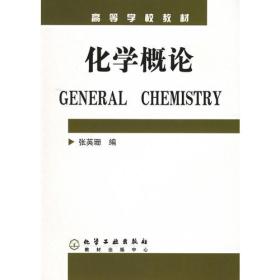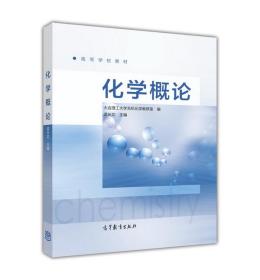
化学概论
批量上传,套装书可能不全,下单前咨询在线客服!图书都是8-9成新,少量涂画,不影响阅读使用!光盘、学习卡、附件等默认不带,有其要求,下单前请咨询客服!
¥ 18.7 5.2折 ¥ 36 九品
仅1件
河北廊坊
认证卖家担保交易快速发货售后保障
作者张英珊 编
出版社化学工业出版社
出版时间2005-01
版次1
装帧平装
货号9787502555917
上书时间2024-12-07
- 最新上架
商品详情
- 品相描述:九品
图书标准信息
- 作者 张英珊 编
- 出版社 化学工业出版社
- 出版时间 2005-01
- 版次 1
- ISBN 9787502555917
- 定价 36.00元
- 装帧 平装
- 开本 其他
- 纸张 胶版纸
- 页数 339页
- 字数 539千字
- 【内容简介】
-
本书是用英语编写的基础化学教材。之所以冠名为“General Chemistry”,是因为在教学改革不断深化的形势下,要求有一门课程能够承担引领学生进入化学科学领域的重要职责。 “General Chemistry”是化学的总纲,在这本书上体现了这种认识和责任。大学一年级的学生不仅可以从这门课中得到对化学科学的系统化认识,更重要的是得到对化学研究科学方法的感知。
本书系统介绍了包括动力学、热力学、原子结构和周期表、化学键和分子结构、化学平衡等内容。纵观整部教材,编者在教学方法及理念上吸收了国外众多优秀教材的长处。如:将近代科学史贯穿于整部教材之中,使学生在学习过程中把握化学发展的脉络;灌输化学研究的科学理念;强调对实验结果归纳总结的重要性,明确指出理论模型是人的创造,其任务是对实验结果进行解释和演绎;在发展过程中必须经过不断的修正,才能使其趋近客观事实。这些均有助于提高学生的科学素养,也是在双语教学中特别应向先进的教学体系学习的。相信此书的出版将会推进化学教学体系的科学化进程。
基础课中引入双语教学会对学生的英语能力,特别是专业英语的能力产生极大的促进作用。
本书可作为大学教育的化学基础课教材,还可以作为教师以及对化学科学的研究方法有兴趣的各行业人员的参考书。本书还特别有助于学习科技英语的学生和从事科技翻译的人员掌握有关化学知识和相关的专业英语。 - 【目录】
-
Chapter1 Gases,GasPhaseEquilibria
1.1 ThePerfect-gasLaw
1.2 ThePartialPressuresofComponentsofaGasMixture
1.3 TheKineticMolecularTheoryofGases
1.4 DiffusionandEffusion
1.5 RealGases
1.6 TheScientificMethod
1.7 ChemicalEquilibriumingaseousstate
1.8 LeChtelier’sPrinciple
1.9 HeterogeneousEquilibria
Chapter2 ChemicalThermodynamics
2.1 FirstLawofThermodynamics
2.2 TheIsothermalExpansionofanIdealGas
2.3 EnthalpyandEnthalpyChange
2.4 SecondLawofThermodynamics
2.5 GibbsFreeEnergyandSpontaneity
2.6 InterpretationofFreeEnergy
Chapter3 ChemicalKinetics
3.1 ReactionRates3
3.2 RateLawsandReactionOrder
3.3 DeterminingtheRateLaw
3.4 TemperatureandRate:AModelforChemicalKinetic
3.5 ReactionMechanisms
3.6 Catalysis
Chapter4 AtomicStructureandthePeriodicTableoftheElements
4.1 Dalton’sAtomicTheory2
4.2 BasicCompositionsofAtoms
4.3 TheBirthoftheQuantumTheory
4.4 TheAtomicSpectrumofHydrogenandBohrTheor
4.5 TheQuantumMechanicalDescriptionofHydrogenAtom
4.6 PolyelectronicAtoms
4.7 ElectronConfigurationsofAtoms
4.8 ElectronDiagramsofAtoms
4.9 ThePeriodicTable
4.10 PeriodicTrendsinAtomicProperties
Chapter5 TheChemicalBond
5.1 TypesofChemicalBonds
5.2 IonicBond
5.3 CovalentBond
5.4 DescribingtheValenceElectronArrangement
5.5 PredictingtheMolecularStructure:TheVSEPRModel
5.6 ValenceBondTheory:HybridOrbitals
5.7 PolarcovalentBond
5.8 BondEnergy
5.9 MolecularOrbitalTheory
5.10 Orbitals:HumanInventions
Chapter6 LiquidandSolid
6.1 IntermolecularForces
6.2 ThePropertiesofLiquidState
6.3 Solidstate
6.4 Lattices
6.5 MetallicCrystals
6.6 IonicCrystals
6.7 CovalentNetworkSolids:CarbonandSilicon
6.8 PhaseTransitions
Chapter7 Acid-BaseEquilibria
7.1 Acid-Baseconcept
7.2 WaterasanAcidandaBase
7.3 RelativeStrengthsofAcidsandBases
7.4 ThepHScale
7.5 CalculatingthepHofWeakAcidSolutions
7.6 Acid-BasePropertiesofSalts
7.7 AcidSolutionsinWhichWaterContributestotheH+Concentration
7.8 CommonIonEffect
7.9 BufferedSolutions
7.10 Acid-BaseTitration
Chapter8 Solutions
8.1 Solubility
8.2 SolubilityEquilibria
8.3 ComplicationsInherentinSolubilityCalculations
8.4 ComplexIonEquilibria
8.5 ColligativeProperties
8.6 ColloidalSolution
Chapter9 Electrochemistry
9.1 ElectrochemicalCells
9.2 StandardReductionPotentials
9.3 ElectrochemistryandThermodynamics
9.4 DependenceoftheCellPotentialonConcentration
9.5 Batteries
9.6 Corrosion
9.7 Electrolysis
9.8 CommercialElectrolyticProcesses
Chapter10 TheMain-GroupElements
Chapter11 TransitionMetalsandCoordinationChemistry
AppendixA MathematicalProcedures
AppendixB SpectralAnalysis
AppendixC NamingSimpleCompounds
AppendixD SelectedThermodynamicData
AppendixE EquilibriumConstantsandStandardReductionPotentials
AppendixF
GLOSSARY
ReferenceMaterials
点击展开
点击收起
相关推荐
— 没有更多了 —















以下为对购买帮助不大的评价